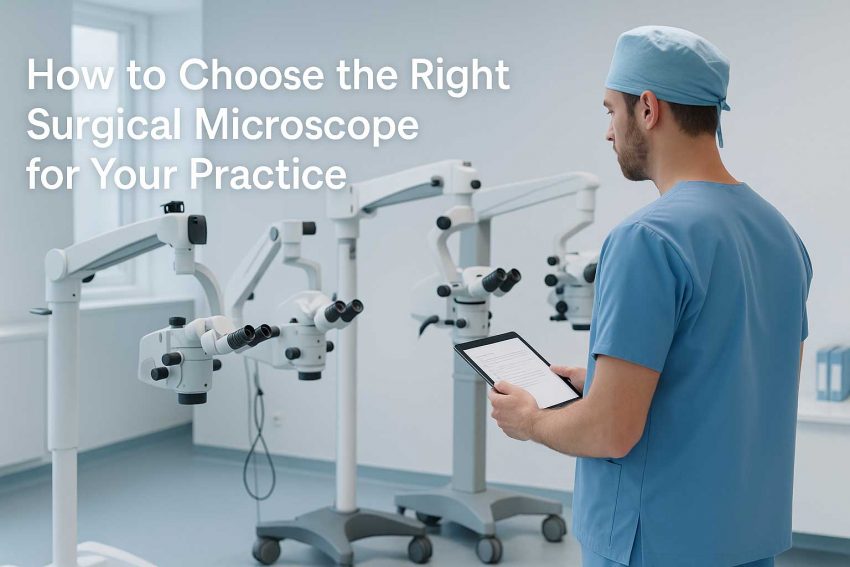Choosing the right surgical microscope can directly affect procedure success, efficiency, and patient outcomes. With so many models, brands, and features on the market in 2025, it’s easy to feel overwhelmed.
This guide walks you through the key factors to consider when selecting a surgical microscope—tailored to your specialty, space, workflow, and long-term goals.
1. Define Your Clinical Specialty and Use Case
The microscope you choose should align with your primary surgical focus. Here’s how needs differ by specialty:
- ENT (Ear, Nose, Throat): Requires compact designs, flexible arms, and shadow-free coaxial illumination.
- Dental: Demands ergonomic scopes with great depth perception and integrated cameras for documentation.
- Neurosurgery: Needs high magnification, motorized control, and long working distances.
- Ophthalmology: Precision optics with fine focus, often with retinal overlays and image guidance.
- Plastic/Reconstructive: Lightweight systems with a wide field of view for fine micro-anastomoses.
Tip: Consider future expansion—if you’ll expand into new procedures, a modular system may be best.
2. Consider Your Space and Mounting Options
Where and how the microscope will be used affects which structure works best:
- Floor-Standing: Flexible and mobile, perfect for clinics or shared spaces.
- Ceiling-Mounted: Ideal for hospitals and complex ORs—maximizes space and stability.
- Wall-Mounted: Saves space in compact rooms, but has limited reach.
- Table-Mounted: Great for fixed stations or portable field kits.
Measure room height and width to ensure proper range of motion, particularly for ceiling booms and large arms.
3. Evaluate Optical and Lighting Performance
Optics determine how clearly you see. Look for these specs:
- Magnification: Range of 4x–40x is ideal; neurosurgery may need more.
- Depth of Field: Wider depth reduces need for constant refocusing.
- Light Source: LED is cool and long-lasting; xenon is brighter but hotter.
- Lens Coating: Improves clarity and reduces glare.
Recommended brands: Zeiss (for precision), Leica (for ergonomics), Seiler or Global Surgical (for value)
4. Look for Digital Features and Integration
Modern surgical microscopes go beyond optics—they’re smart systems. Choose features that match your workflow:
- Built-in HD or 4K cameras for video documentation or teaching
- DICOM/PACS integration for hospital network syncing
- AR overlays for guided surgery (especially in neuro/ophthalmic)
- Foot pedal/joystick control for hands-free precision
Teaching hospitals may need dual viewer ports or a secondary monitor output.
5. Set Your Budget (and Consider Total Cost of Ownership)
Microscopes range from $8,000 to $200,000+ depending on brand, features, and installation.
Don’t just compare sticker prices—consider:
- Maintenance and service contracts
- Required accessories or software
- Training and onboarding time
- Future resale value or trade-in programs
For smaller practices, Seiler or Labomed offer great entry-level systems. For complex surgery, Zeiss and Leica deliver long-term value.
6. Choose the Right Vendor or Distributor
Where you buy your microscope matters. Consider:
- Reputation and customer service history
- Local service and repair turnaround times
- Delivery, setup, and calibration support
- Post-sale training and documentation
It’s also worth asking for live demos or trial periods before committing.
Summary Checklist
- Match microscope design to surgical specialty
- Choose mounting based on space and layout
- Compare optics: magnification, clarity, lighting
- Look for integration: camera, AR, foot control
- Balance cost with long-term value
- Select a vendor who supports your growth
Final Thoughts
There’s no one-size-fits-all microscope. The right surgical microscope supports clinical precision, surgeon comfort, and workflow efficiency.
Whether you need a basic setup for dental work or a robotic microscope for neurosurgery, taking the time to assess your needs will ensure a smart investment for your practice in 2025 and beyond.
